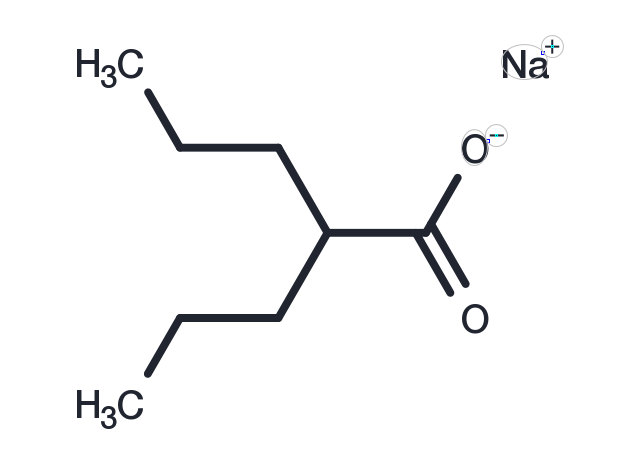Powder: -20°C for 3 years | In solvent: -80°C for 1 year
Valproic acid sodium salt (Sodium Valproate) is the sodium salt form of valproic acid with anti-epileptic activity. Valproic acid sodium salt is converted into its active form, valproate ion, in blood. Although the mechanism of action remains to be elucidated, Valproic acid sodium salt increases concentrations of gamma-aminobutyric acid (GABA) in the brain, probably due to inhibition of the enzymes responsible for the catabolism of GABA. This potentiates the synaptic actions of GABA. Valproic acid sodium salt may also affect potassium channels, thereby creating a direct membrane-stabilizing effect.

| パッケージサイズ | 在庫状況 | 単価(税別) | |||
|---|---|---|---|---|---|
| サンプルについてお問い合わせ | |||||
| 500 mg | 在庫あり | ¥ 10,000 | |||
| 1 g | 在庫あり | ¥ 11,500 | |||
| 5 g | 在庫あり | ¥ 13,500 | |||
| 25 g | 在庫あり | ¥ 15,500 | |||
| 説明 | Valproic acid sodium salt (Sodium Valproate) is the sodium salt form of valproic acid with anti-epileptic activity. Valproic acid sodium salt is converted into its active form, valproate ion, in blood. Although the mechanism of action remains to be elucidated, Valproic acid sodium salt increases concentrations of gamma-aminobutyric acid (GABA) in the brain, probably due to inhibition of the enzymes responsible for the catabolism of GABA. This potentiates the synaptic actions of GABA. Valproic acid sodium salt may also affect potassium channels, thereby creating a direct membrane-stabilizing effect. |
| ターゲット&IC50 | HDAC1:0.4 mM |
| In vitro | In the MT-450 rat mammary carcinoma model, Valproic acid exhibits a delayed effect on the growth of primary tumors. |
| In vivo | In cultured cells, Valproic acid induces histone deacetylation similarly to the histone deacetylase inhibitor Trichostatin A, and like Trichostatin A, activates the transcription of various exogenous and endogenous promoters. However, in the embryos of vertebrates, both Valproic acid and Trichostatin A exhibit teratogenic effects without activating transcription. Valproic acid directly inhibits histone deacetylases through distinct pathways, with an IC50 of 0.4 mM for HDAC1. It inhibits cell proliferation or survival in F9 and P19 teratocarcinoma cells, as indicated by a decrease in [3H]thymidine incorporation, and promotes peroxisome proliferation in the liver of rodents. At a concentration of 1 mM, Valproic acid inhibits the release of Gal4 fused with N-COR, TR, or PPARδ in cells expressing the DNA binding domain of the glucocorticoid receptor and the ligand-binding domain of PPARδ, along with a GR-controlled reporter gene fusion. Valproic acid reduces the accumulation of acetylated histones and inhibits HDAC activity. Furthermore, Valproic acid induces specific types of differentiation, characterized by decreased proliferation, morphological changes, accumulation of the transcription factor AP-2, and expression of marker genes, where AP-2 serves as a potential marker for neuronal or neuroepithelial-like differentiation in F9 teratocarcinoma cells. |
| キナーゼ試験 | The activity of caspase-3, -8 and -9 is assessed using the caspase-3, -8 and -9 colorimetric assay kits, respectively. In brief, 1×106?cells in a 60-mm culture dish are incubated with 10 mM Valproic acid for 24 h. The cells are then washed in PBS and suspended in 5 volumes of lysis buffer provided with the kit. Protein concentrations are determined using the Bradford method. Supernatants containing 50 μg total protein are used to determine caspase-3, -8 and -9 activities. The supernatants are added to each well in 96-well microtiter plates with DEVD-pNA, IETD-pNA or LEHD-pNA as caspase-3, -8 and -9 substrates and the plates are incubated at 37°C for 1 h. The optical density of each well is measured at 405 nm using a microplate reader. The activity of caspase-3, -8 and -9 is expressed in arbitrary absorbance units. |
| 細胞研究 | Valproic acid is dissolved in DMSO. In brief, 5×105?cells are seeded in 96-well microtiter plates for MTT assays. After exposure to the designated doses of Valproic acid for the indicated times, MTT solution [20 mL: 2 mg/mL in phosphate-buffered saline (PBS)] is added to each well of the 96-well plates. The plates are additionally incubated for 3 h at 37°C. Medium is withdrawn from the plates by pipetting and 200 mL DMSO is added to each well to solubilize the formazan crystals. The optical density is measured at 570 nm using a microplate reader. |
| 別名 | Sodium Valproate |
| 分子量 | 166.2 |
| 分子式 | C8H15NaO2 |
| CAS No. | 1069-66-5 |
Powder: -20°C for 3 years | In solvent: -80°C for 1 year
DMSO: 50 mg/mL (300.84 mM)
H2O: 16.6 mg/mL (100 mM)
You can also refer to dose conversion for different animals. 詳細
bottom
Please see Inhibitor Handling Instructions for more frequently ask questions. Topics include: how to prepare stock solutions, how to store products, and cautions on cell-based assays & animal experiments, etc.
Valproic acid sodium salt 1069-66-5 Autophagy Chromatin/Epigenetic DNA Damage/DNA Repair Membrane transporter/Ion channel Microbiology/Virology Neuroscience Proteases/Proteasome Stem Cells Mitophagy GABA Receptor HIV Protease Gamma-secretase HDAC bipolar disorder Valproic acid anticonvulsant SCLC hepatic fat accumulation degradation Histone deacetylases HIV Mitochondrial Autophagy Notch inhibit Apoptosis Sodium Valproate anticancer Endogenous Metabolite headaches epilepsy small cell lung cancer Inhibitor Human immunodeficiency virus proteasomal Notch1 Valproic acid sodium migraine inhibitor
